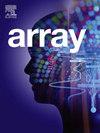Integrating clustering with evolutionary feature selection using ENORA and SToWVector
IF 4.5
Q2 COMPUTER SCIENCE, THEORY & METHODS
引用次数: 0
Abstract
The rapid growth of textual data from sources such as social media, blogs, and digital libraries has intensified the demand for scalable and semantically informed classification methods. This study introduces a hybrid framework that integrates unsupervised clustering, evolutionary feature selection, and semantic interpretation to enhance automatic text classification. The approach combines the SToWVector representation with a Multi-Objective Evolutionary Search (MOES) strategy optimized through the ENORA algorithm, while employing the NaiveBayesMultinomial classifier for evaluation. Semantic interpretation is incorporated via ontological reasoning, enabling the model to capture latent conceptual relationships among terms and thereby complement both the clustering and feature selection processes. Experimental evaluations on benchmark and large-scale datasets (SMS Spam and Euronews) demonstrate the robustness of the framework, including a scenario in which 100% accuracy was achieved. The proposed method outperforms traditional models and achieves competitive results against deep learning-based classifiers. These findings underscore the framework’s adaptability and effectiveness in managing high-dimensional unstructured text, while preserving interpretability through symbolic reasoning.
利用ENORA和SToWVector将聚类与进化特征选择相结合
来自社交媒体、博客和数字图书馆等来源的文本数据的快速增长,加剧了对可扩展和语义知情的分类方法的需求。本研究引入了一个混合框架,该框架集成了无监督聚类、进化特征选择和语义解释,以增强自动文本分类。该方法将SToWVector表示与通过ENORA算法优化的多目标进化搜索(MOES)策略相结合,同时采用NaiveBayesMultinomial分类器进行评估。语义解释通过本体论推理结合,使模型能够捕获术语之间潜在的概念关系,从而补充聚类和特征选择过程。在基准和大规模数据集(SMS Spam和euronenews)上的实验评估证明了该框架的鲁棒性,包括实现100%准确率的场景。该方法优于传统模型,并与基于深度学习的分类器取得了竞争结果。这些发现强调了框架在管理高维非结构化文本方面的适应性和有效性,同时通过符号推理保持可解释性。
本文章由计算机程序翻译,如有差异,请以英文原文为准。
求助全文
约1分钟内获得全文
求助全文

 求助内容:
求助内容: 应助结果提醒方式:
应助结果提醒方式:


